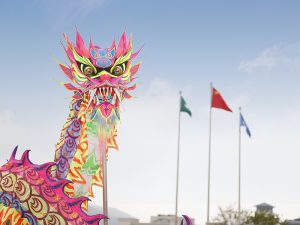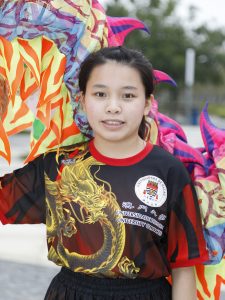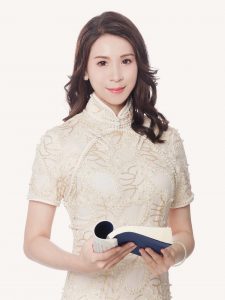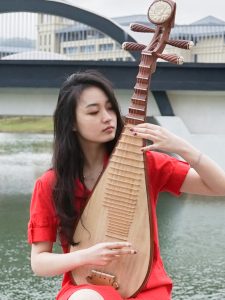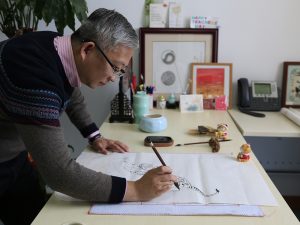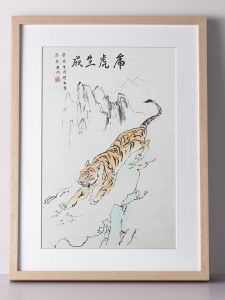Traditional Chinese culture has a profound history and encompasses a wide range of elements, including customs (such as dragon dance and lion dance), festivals, thoughts, art forms (such as Chinese music, Chinese chess, Chinese calligraphy, and Chinese painting), literature, languages, and traditional Chinese medicine. These elements have become not only an ingrained part of our daily lives but also a spiritual force in our pursuit of a better life. In this issue, we interviewed several UM members, who shared the reasons for their love of traditional Chinese culture.
Dragon and Lion Dance as a Symbol of National Unity
Charlotte Lao, a second-year electrical and mechanical engineering major and a member of Cheng Yu Tung College, was introduced to the dragon and lion dances during her freshman year in a physical education course, where she learned the basic skills of the lion dance. Later, she attended a seminar organised by the Macao Dragon and Lion Dance Team and learned more about the history of the dragon and lion dances. ‘After attending that seminar, I realised that lion and dragon dance has a long history in Macao,’ she says. ‘I believe that this is a symbol of the Chinese nation and conveys a spirit of national unity. It is not simply a matter of the dancers moving the lion or the dragon; it is more about the dancers being agile and working together to “bring the lion or dragon to life”. When performed with a drumming ensemble, it creates a lively atmosphere and can leave a memorable impression on the audience.’ Lao was so intrigued that she applied to join the UM Dragon Dance Team after attending the seminar.
Since its inception in 2019, the UM Dragon Dance Team has been committed to preserving and spreading traditional Chinese culture. Currently the assistant to the team captain, Lao believes that dragon dance is an art form jointly created by working people and artists, and is a kind of group fitness exercise. ‘I hope that every time we perform, we can arouse the audience’s interest in the dragon and lion dance routines and steps, and bring them a joyful and auspicious festive atmosphere,’ says Lao.
A Poetry-loving Cultural Ambassador
Jessie Ng, a master ’s student majoring in Chinese history and culture, began reading the Four Great Chinese Novels in primary school under the influence of her family . ‘My favourite of the Four Great Novels is The Dream of the Red Chamber, and I was fascinated by the plot and characters in the book when I first read it,’ says Ng. ‘This book introduced me to the world of Chinese culture.’ Ng is also a poet, poetry reciter, the first Cultural Ambassador of the Cultural Affairs Bureau of Macao, and the first Chinese Cultural Ambassador of UM, actively promoting Chinese history, culture, and poetry.
Ng believes that the MA programme at UM has allowed her to explore the profound Chinese culture in greater depth. Last semester , she took the Introduction to Chinese History and Culture course taught by Visiting Professor Zheng Dehua in the Centre for Chinese History and Culture at UM. One of her assignments was to write an article on the development of A-Ma culture in Macao. In addition to examining how A-Ma culture, which originated in Fujian province, has developed and transformed in Macao, Ng also discussed innovative ways to promote this culture in Macao. ‘I have come to understand that Macao’ s culture is in fact inherited from Chinese culture, and I have been thinking about how to pass on Chinese culture to the next generation,’ she says. Ng is currently teaching Chinese language at Salesian Institute. She uses part of the assignments in her master’s programme as teaching material for a class on Macao’ s poetry and culture to guide her students to think about the meaning of Chinese culture.
Promoting Traditional Chinese Culture through Music
Psychology major Gao Cijun joined the UM Chinese Orchestra in her first year and went on to study for her PhD straight after graduation. Still a member of the Chinese Orchestra, she says: ‘The orchestra has highly skilled conductors and instructors, and we often compare notes and have learned a lot from each other .’
When she was a child, the first instrument she learned was the piano. However , after hearing a Pipa teacher play in a musical instrument s hop, she was instantly attracted to the sound of the Pipa and the elegance of the teacher when playing the music. So she told her mother, ‘I want to learn it!’
Gao has been playing the Pipa for 17 years. She says: ‘Traditional Chinese music has always played an important role in the spread of Chinese culture, and its repertoire embodies the historical and cultural aspects of China. For example, the Pipa piece “Ambush from Ten Sides” depicts the Battle of Gaixia during the Chu-Han contention. Playing Chinese music has enriched my understanding of Chinese history and culture.’
The Commonalities between Chinese Medicine and Chinese Painting
Chinese medicine and Chinese painting are both gems of traditional Chinese culture. Zhao Yonghua, assistant professor in the Institute of Chinese Medical Sciences, is passionate about Chinese painting and is dedicated to clinical research and pharmacological experiments on the prevention and treatment of cardiovascular and cerebrovascular diseases by combining Chinese medicine and Western medicine. With the support of the Macao Science and Technology Development Fund, Prof Zhao and his team are currently conducting a research project on the association between Chinese medicine and cognitive impairment in the elderly in Macao. Prof Zhao’s team and another team led by Prof Yuan Zhen in the Faculty of Health Sciences are using MRI technology to screen the elderly for early diagnosis of cognitive impairment, hoping to slow down the development of the disease through Chinese medicine intervention and to boost the mental health and wellbeing of the elderly in Macao. ‘Inclusiveness is the hallmark of Chinese culture,’ says Prof Zhao. ‘For more than 2,000 years, Chinese culture has adopted an open and tolerant attitude in absorbing the essence of different time periods and foreign cultures. Chinese medicine is an important part of Chinese culture, and it has developed to the point where it is necessary to incorporate modern technology into Chinese medicine treatment or research with an open attitude. According to my clinical experience over the years, many diseases with a clear diagnosis can be treated more effectively if we combine Western medicine and Chinese medicine.’
Zhao began learning Chinese painting in primary school. He has a PhD from the Guangzhou University of Chinese Medicine and is a veteran Chinese medicine practitioner himself. ‘Chinese medicine is about maintaining a balance between yin and yang. In treating illnesses, Chinese medicine focuses on mobilising the body’s ability to fight disease and restore balance in the body,’ he says. ‘In the process of painting, one needs to adjust one’s breathing and exhale naturally, so that the body and mind are in a state of harmony. The creation of Chinese paintings in fact has something in common with the way Chinese medicine practitioners maintain their health.’
Source: My UM ISSUE 111

